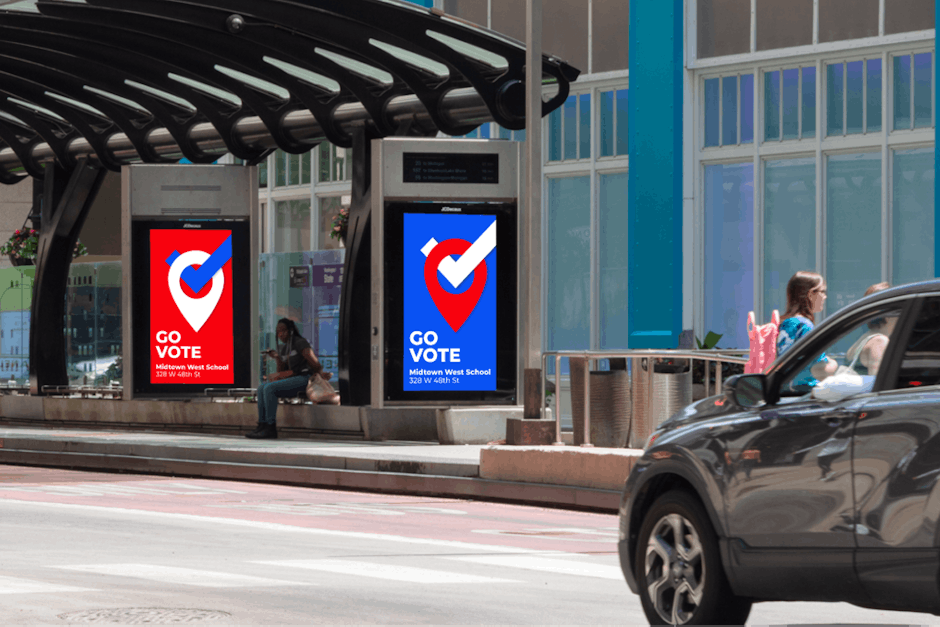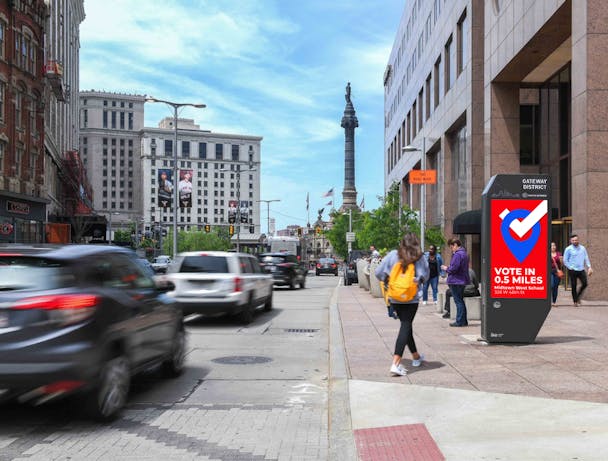OOH advertising: Political advertising strategies for the 2024 US presidential election
Leslie Lee, SVP of marketing at Vistar Media, shares how advertisers can use digital out of home to reach potential voters leading up to the election.

Election year is upon us, both in the US and abroad. In fact, this year’s political ad spending will be the costliest in US history at over $12bn, according to eMarketer.
With concerns over misinformation and disinformation on social media, and the limited TV and connected TV (CTV) inventory going for high rates, advertisers seeking the combination of mass reach and trust should consider digital out of home (DOOH) advertising.
Reach key voters at scale
Out of home (OOH) is one of the most trusted media channels out there - a recent study conducted for the OAAA by The Harris Poll found that a staggering 73% of consumers expressed a favorable view of DOOH ads. This significantly surpassed other forms of ad media, such as television/video (50%), social media (48%), online (37%), audio (32%) and print (31%).
This isn’t too much of a surprise, though, considering it’s one of the only media channels that doesn’t interrupt a consumer. It lives in the physical world, and naturally coexists within peoples’ everyday lives – whether along highways, in their local malls, at gas stations, gyms, restaurants and more. In short: OOH fits within a consumers’ daily journey vs. interfering with it.
Not only is it a trustworthy and non-invasive media channel, but it also offers the scale and targeting capabilities to reach a desired audience of prospective voters. Here’s how:
Personas
Meet your audience where they are using lifestyle and behavioral patterns based on the locations they visit. This could be targeting an audience segment of young voters, first-time voters or even small business owners.
Local audiences
Hyper-focus on local audiences using zip codes and county data, such as targeting prospective voters based on town zip codes, county targeting or state targeting.
Voter files
Onboard first-party data or leverage third-party data to find audiences based on voter registration or political affiliation. This could include identifying voter registration status, political party switchers or even political leaders, and serving up relevant ads based on this information.
Target the best screens for political messaging
One beauty of DOOH media is that there are screens everywhere. From large-format billboards in Times Square or alongside major highways, to place-based screens found in office buildings, bars, universities and other locations where people regularly spend time, there’s no shortage of ways to amplify your message through OOH.
Some demand-side platforms (DSP) even offer political auction packages, which essentially pre-package specific screens that are compliant with certain political messages. This helps advertisers easily navigate the restrictions placed on political ads so your campaign goes live safely and at scale.
In addition to offering the necessary scale to spread your message far and wide to those who matter most, DOOH offers even more targeting capabilities that can help you drill into where a potential voter is most likely to be. Here’s a few examples of how you can bring this to life:
Proximity targeting
With proximity targeting (sometimes called point-of-interest targeting), you can strategically place ads where voters are most likely to react, such as near federal buildings in key municipalities or around political conferences and debates.
Time- or day-parting
Timing is everything in marketing and politics, and with day-parting, you can choose the perfect moment for your ad to go live. If you’re activating OOH media near office buildings, perhaps the best time is in the early morning when an audience is mostly likely commuting into work, or if you’re targeting gyms, perhaps you choose early mornings and evenings to catch people who are hitting the gym outside of work hours.
Use messaging that actually resonates
Another benefit of using OOH in your political advertising campaign is the creative flexibility of the channel. When it comes to advertising a political message, the focus could be on a variety of messages from general get out and vote encouragement to specific policies, candidate profiles and more. However, regardless of the message being conveyed, it’s key to drive as much relevance and personalization as possible for an ad to actually resonate with an audience.
Here are a few ways to optimize your political message across OOH:
Connect your CTV and outdoor ads
With CTV making up 45% of all digital political ad spending this year (compared to 19% in the last presidential election), it’s possible this channel is already in your media mix for the upcoming election. So, consider combining your CTV and OOH ads to increase reach while keeping your message consistent. Tip: 85% of DOOH screens accept video assets, making it relatively simple to repurpose existing CTV assets across OOH.
Promote upcoming events
Consider promoting upcoming campaign events, rallies and opportunities for voters that are relevant to your brand or organization. Amplifying key event messages across a mass reaching channel like OOH can increase the odds of reaching those who may be on the partisan fence.
Include a countdown to the election to drive urgency
With dynamic creative technology, which changes messages and images based on data, you can implement a countdown that changes automatically leading up to election day to drive urgency to vote.
Advertise the nearest voting location
Perhaps you’re trying to reach last minute or on the fence voters – consider integrating the nearest voting location into creatives to personalize the experience and also encourage voting in real-time.

To reach voters in a tumultuous and sensitive political environment is not easy. You have to put yourself in the shoes of the voters – they may feel divided and uncertain, while being bombarded with marketing messages from every angle (and often by messages that aren’t actually personalized to them). The key is authenticity, and to reach them using channels that don’t cause further distrust before they even see your message.
OOH is just one way to do that, blending in with peoples’ everyday lives, and offers the necessary targeting capabilities and creative flexibility to reach prospective voters with messages that actually resonate and inspire action.

